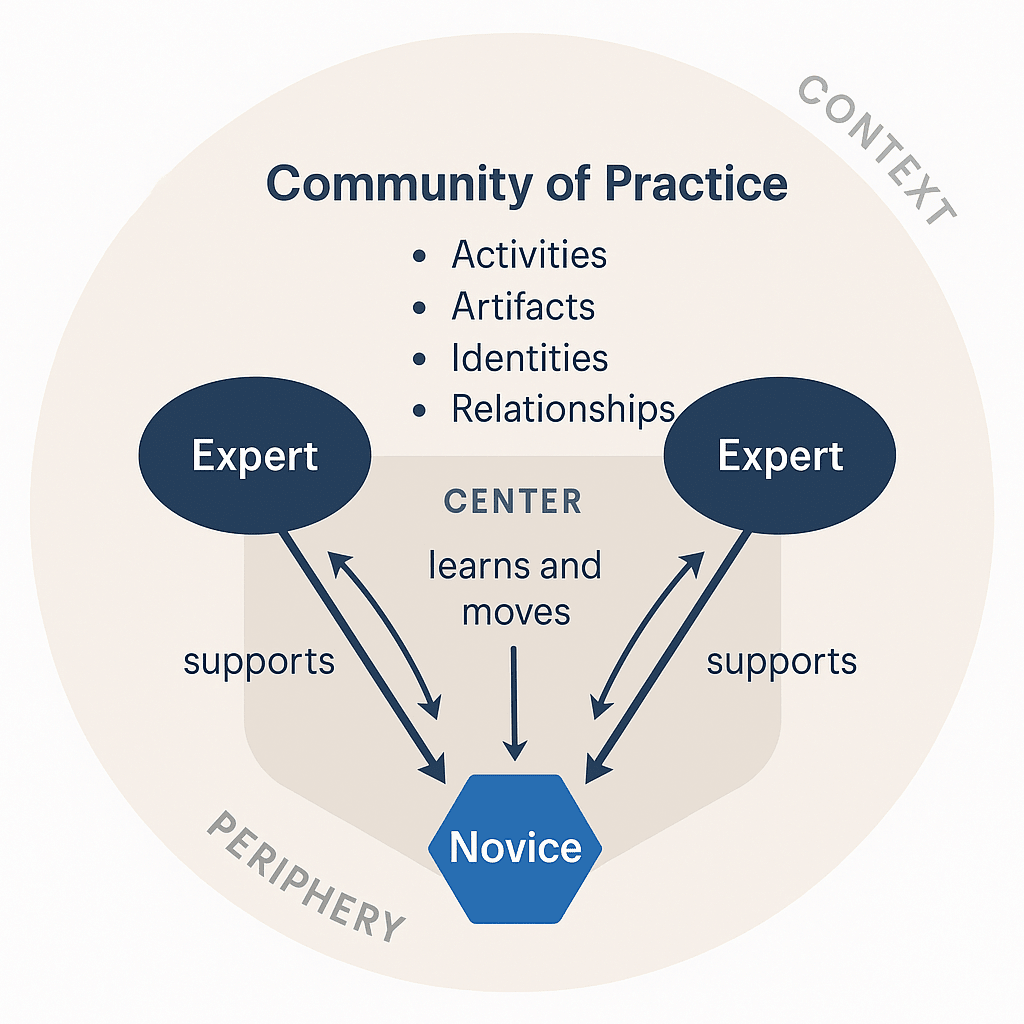What is Situated Learning Theory?
Originally developed by Jean Lave and Etienne Wenger in the early 1990s, the theory proposes that learning occurs through participation in meaningful social practices within a given environment.

Originally developed by Jean Lave and Etienne Wenger in the early 1990s, the theory proposes that learning occurs through participation in meaningful social practices within a given environment. Learners actively engage with others, tools, and tasks in ways that reflect real-world activity.
A core concept within Situated Learning is legitimate peripheral participation. This refers to how newcomers begin learning by observing and participating in simple tasks within a community of practice. Over time, as their understanding and skills develop, they take on more complex responsibilities and move closer to full participation. The culture and norms of the learning environment are gradual, social, and heavily influence this process.

Legitimate Peripheral Participation
Lave and Wenger introduced this concept to describe how individuals learn by becoming gradually involved in the practices of a community, starting from the margins and moving inward as they build expertise and confidence. We first unpack its three elements:
- Legitimacy: The learner’s role must be recognised as valid by the community. This doesn’t mean full competence; rather, it means the learner is seen as a genuine participant, even at the early stages. Legitimacy creates psychological safety and permits learners to engage without needing to perform at an expert level.
- Peripherality: Peripheral tasks are those that are lower in complexity or responsibility but still embedded in the real practices of the group. These might include observing, assisting, or performing smaller components of a larger task. It allows learners to interact meaningfully with their environment at a level that matches their current skill set.
- Participation: Learning happens through doing, not only by watching or listening. Participation involves hands-on engagement with the tasks, tools, language, and social norms of the community. Over time, learners take on more central roles as their knowledge and identity develop.
Learning as Trajectory, Not Transfer
Most learning models often rely on a “knowledge transfer” metaphor;teachers transmit, students receive. LPP replaces this with a trajectory metaphor, emphasising movement and progression within a social system. A learner’s development is also about becoming someone who can participate meaningfully in a practice.
It recognises that knowledge is deeply tied to who we are and how we act within our social worlds. It places equal importance on skill development and identity formation. A student learning to become a scientist, for instance, apart from learning methods and theories, is also learning how to ask questions, communicate findings, and think logically within the norms of the scientific community.
Communities of Practice (CoP)
This is perhaps the most foundational concept next to LPP in Situated Learning Theory. Communities of practice are the social structures in which situated learning occurs. A community of practice is a group of individuals who share a concern, a set of problems, or a passion for a topic, and who deepen their knowledge and expertise through ongoing interaction. Learning, in this view, is about becoming a member of a community and contributing meaningfully to its shared practices. These communities are dynamic and evolve, just like the learners within them.
Authentic Activities
Situated Learning Theory emphasises that knowledge must be acquired in contexts that reflect its actual use. These are authentic activities, tasks that resemble the way problems and practices occur in the real world.
Situated Cognition
Situated cognition emphasises on how thinking and knowing are shaped by the context in which they occur. It challenges the notion that cognition is an isolated, abstract mental process. Instead, it suggests that knowledge is constructed through interaction with tools, environments, and other people, and is inseparable from the activity, context, and culture in which it is used.
One of the clearest educational applications of situated cognition is the science laboratory. After lecture or textbook reading, science labs engage students in authentic, hands-on activities that mirror the precautions, methodology and practices of professional scientists.
Identity Development
Finally, as learners move through communities, engage in authentic activity, and build competence, they start to reshape their identities. This is known as the trajectory of becoming. Students participating in a robotics club, for example, start to see themselves as engineers, builders, and problem-solvers.

Adiutor
Adiutor means "helper" - we do just that, by taking a load of your school administration and helping you focus on what matters most: the kids.
References
Lave, J., & Wenger, E. (1991). Situated learning: Legitimate peripheral participation. Cambridge University Press.
Wenger, E. (1998). Communities of practice: Learning, meaning, and identity. Cambridge University Press.
Brown, J. S., Collins, A., & Duguid, P. (1989). Situated cognition and the culture of learning. Educational Researcher, 18(1), 32–42.
Greeno, J. G., Collins, A. M., & Resnick, L. B. (1996). Cognition and learning. In D. Berliner & R. Calfee (Eds.), Handbook of educational psychology (pp. 15–46). Macmillan.
Barab, S. A., & Duffy, T. M. (2000). From practice fields to communities of practice. In D. H. Jonassen & S. M. Land (Eds.), Theoretical foundations of learning environments (pp. 25–55). Lawrence Erlbaum Associates.
Sfard, A. (1998). On two metaphors for learning and the dangers of choosing just one. Educational Researcher, 27(2), 4–13.
